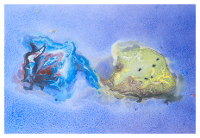Speaker
Prof.
Francisco Fernandez
(Universidad de Salamanca)
Description
The hadronic transitions of heavy quarkonia such as $\psi
(nS)$ or $\Upsilon(nS)$ to lower states with emission of two pions are important tools for
understanding both, the heavy quarkonium dynamics and the formation of light hadrons.
The typical momentum involve in the transition is too low for perturbative QCD and then perturbative method does not apply.
The recent experimental data shows a puzzling behavior. In charmonium each $Y(4260)$, $Y(4360)$ and $Y(4660)$ decay to only one particular channel, $J/\psi \pi^+ \pi^-$ or $\psi(2S) \pi^+ \pi^-$, showing the $Y(4360)$ and $Y(4660)$ a particularly large width. Moreover, such decays have not been observed for the $\psi(4415)$. In bottomoiun, the $\Upsilon(10860)$ also shows an anomalous large width [1].
These behaviors can be due to several mechanism: contribution of hadronic loops, four quarks molecular components of the quarkonium wave function or the existence of hybrids mesons with a mass near the mass of the decaying resonance.
In this work we address these problems in the framework of a constituent quark model which has been successful in describing the hadronic phenomenology [2].
Hadronic decays can be described, at least for the lower lying states, using the QCD multipole expansion approach (QCDME) where the heavy quarkonium system serves as a compact color source and emits soft gluons which are hadronized into pions. After the emission of the first gluon and before de emission of the second there exist an intermediate state where the $q\bar q$ together with the gluon constitute an hybrid state. The width of the transition depends critically on the position of this state, therefore it is important to describe the $q\bar q$ states and the hybrid consistently using as few parameters as possible.
Moreover, when the excited states lies above the open flavor threshold, the QCDME scenario may change because the possible contribution of molecular components [3] can enhanced the decay width.
Using the constituent quark model quoted above, we calculate the $J/\psi \pi \pi$ and $\psi(2S) \pi \pi$ decays of the $J^P=1^{--}$ charmonium and bottomonium states. Hybrid states are consistently generated in the original quark model using the quark confining string (QCS) scheme [4]. Above threshold we incorporate the effects of molecular components.
We are able to explain the anomalous large decay width of the $X(4360)$ and $Y(4660)$ due to the presence of hybrid states close by in energies. However this mechanism does not work in the case of the $\Upsilon(10860)$ being in this case the large width due to the contributions of significant molecular components. Our model also predicts a large value for the decay $X(4360)\rightarrow J/\psi \pi \pi$ which has been not seen in the experiments. Therefore the puzzling situation of the hadronic transition in quarkonium still deserves more experimental and theoretical efforts.
\vspace
[1] N. Bambrilla {\it et al.},
Eur. Phys. J. C {\bf 71}, 1334 (2011).
J. P Lees{\it et al} Phys Rev D {\bf 86} 051102 (2012).
J. P Lees{\it et al} arXiv:1211.6271v2.
[2] J. Vijande, F. Fern\'andez, and A. Valcarce,
J. Phys. G {\bf 31}, 481 (2005).
J. Segovia, A. M. Yasser, D. R Entem and F. Fern\'andez,
Phys. Rev. D {\bf 78} 114033 (2008).
[3]P. G. Ortega, D. R. Entem and F. Fern\'andez,
J. Phys. G {\bf 40} 065107 (2013).
[4]R. C. Giles ans S.-H. H. Tye Phys. Rev. D {\bf 16} 1079 (1977).
Summary
We study the anomalously large rates of some hadronic transition from quarkonium in a constituent quark model which has been successful in describing the hadronic phenomenology. Some of the anomalies are explained due to the presence of hybrid states in the QCD multipole expansion approach whereas others are due to the presence of molecular components in the state wave function
Author
Prof.
Francisco Fernandez
(Universidad de Salamanca)
Co-authors
Prof.
David R. Entem
(Universidad de Salamanca)
Dr
Jorge Segovia
(Universidad de Salamanca)
Dr
Pablo G. Ortega
(CERN)
